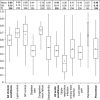The comprehensive care project: measuring physician performance in ambulatory practice
- PMID: 20819110
- PMCID: PMC3029848
- DOI: 10.1111/j.1475-6773.2010.01160.x
The comprehensive care project: measuring physician performance in ambulatory practice
Abstract
Objective: To investigate the feasibility, reliability, and validity of comprehensively assessing physician-level performance in ambulatory practice.
Data sources/study setting: Ambulatory-based general internists in 13 states participated in the assessment.
Study design: We assessed physician-level performance, adjusted for patient factors, on 46 individual measures, an overall composite measure, and composite measures for chronic, acute, and preventive care. Between- versus within-physician variation was quantified by intraclass correlation coefficients (ICC). External validity was assessed by correlating performance on a certification exam.
Data collection/extraction methods: Medical records for 236 physicians were audited for seven chronic and four acute care conditions, and six age- and gender-appropriate preventive services.
Principal findings: Performance on the individual and composite measures varied substantially within (range 5-86 percent compliance on 46 measures) and between physicians (ICC range 0.12-0.88). Reliabilities for the composite measures were robust: 0.88 for chronic care and 0.87 for preventive services. Higher certification exam scores were associated with better performance on the overall (r = 0.19; p<.01), chronic care (r = 0.14, p = .04), and preventive services composites (r = 0.17, p = .01).
Conclusions: Our results suggest that reliable and valid comprehensive assessment of the quality of chronic and preventive care can be achieved by creating composite measures and by sampling feasible numbers of patients for each condition.
© Health Research and Educational Trust.
Figures
Similar articles
-
Impact of remuneration and organizational factors on completing preventive manoeuvres in primary care practices.CMAJ. 2012 Feb 7;184(2):E135-43. doi: 10.1503/cmaj.110407. Epub 2011 Dec 5. CMAJ. 2012. PMID: 22143227 Free PMC article.
-
Variation and statistical reliability of publicly reported primary care diagnostic activity indicators for cancer: a cross-sectional ecological study of routine data.BMJ Qual Saf. 2018 Jan;27(1):21-30. doi: 10.1136/bmjqs-2017-006607. Epub 2017 Aug 28. BMJ Qual Saf. 2018. PMID: 28847789 Free PMC article.
-
Measuring data reliability for preventive services in electronic medical records.BMC Health Serv Res. 2012 May 14;12:116. doi: 10.1186/1472-6963-12-116. BMC Health Serv Res. 2012. PMID: 22583552 Free PMC article.
-
Focus on quality: profiling physicians' practice patterns.J Ambul Care Manage. 1994 Jul;17(3):44-75. doi: 10.1097/00004479-199407000-00008. J Ambul Care Manage. 1994. PMID: 10171938
-
Primary care physician practice styles and quality, cost, and productivity.Am J Manag Care. 2020 Apr 1;26(4):e127-e134. doi: 10.37765/ajmc.2020.42840. Am J Manag Care. 2020. PMID: 32270990
Cited by
-
Setting a fair performance standard for physicians' quality of patient care.J Gen Intern Med. 2011 May;26(5):467-73. doi: 10.1007/s11606-010-1572-x. Epub 2010 Nov 23. J Gen Intern Med. 2011. PMID: 21104453 Free PMC article.
-
Performance-based payment systems for general practitioners and specialists in selected countries: a comparative study.J Prev Med Hyg. 2025 May 31;66(1):E114-E125. doi: 10.15167/2421-4248/jpmh2025.66.1.3511. eCollection 2025 Mar. J Prev Med Hyg. 2025. PMID: 40756201 Free PMC article.
-
Composite measures of quality of health care: Evidence mapping of methodology and reporting.PLoS One. 2022 May 12;17(5):e0268320. doi: 10.1371/journal.pone.0268320. eCollection 2022. PLoS One. 2022. PMID: 35552561 Free PMC article.
-
Which practice characteristics are associated with the quality of cardiovascular disease prevention in European primary care?Implement Sci. 2013 Mar 9;8:27. doi: 10.1186/1748-5908-8-27. Implement Sci. 2013. PMID: 23510482 Free PMC article.
-
Is There a Doctors' Effect on Patients' Physical Health, Beyond the Intervention and All Known Factors? A Systematic Review.Ther Clin Risk Manag. 2022 Jul 21;18:721-737. doi: 10.2147/TCRM.S372464. eCollection 2022. Ther Clin Risk Manag. 2022. PMID: 35903086 Free PMC article. Review.
References
-
- Agency for Healthcare Quality and Research (AHRQ) 2005. “National Healthcare Quality Report” [accessed on January 4, 2010]. Available at http://www.ahrq.gov/qual/nhqr05/nhqr05.htm.
-
- American College of Physicians (ACP) 2007. “Joint Principles of the Patient-Centered Medical Home” [accessed on January 4, 2010]. Available at http://www.acponline.org/advocacy/where_we_stand/medical_home/approve_jp....
-
- Asch SM, McGlynn EA, Hogan MM, Hayward RA, Shekelle P, Rubenstein L, Keesey J, Adams J, Kerr EA. Comparison of Quality of Care for Patients in the Veterans Health Administration and Patients in a National Sample. Annals of Internal Medicine. 2004;141:938–45. - PubMed
-
- Bodenheimer T. Coordinating Care—A Perilous Journey through the Health Care System. New England Journal of Medicine. 2008;358:1064–71. - PubMed
-
- Boyd CM, Darer J, Boult C, Fried LP, Boult L, Wu AW. Clinical Practice Guidelines and Quality of Care for Older Patients with Multiple Comorbid Diseases: Implications for Pay for Performance. Journal of American Medical Association. 2005;294:716–24. - PubMed
Publication types
MeSH terms
LinkOut - more resources
Full Text Sources
Other Literature Sources


